Tectonic Implication of the 2022 MS 6.9 Earthquake in Menyuan, Qinghai, China: Analysis of Precise Earthquake Locations and InSAR
Abstract
:1. Introduction
2. Historical Earthquake and Tectonic Background of Menyuan Earthquake
2.1. Historical Earthquake Information of Menyuan
2.2. Tectonic Background
3. Data and Methods
3.1. Absolute Location of the Earthquake Sequence
3.2. Double-Difference Method for Precise Location
3.3. InSAR Coseismic Deformation
3.4. Inversion of Slip Distribution
4. Discussion
4.1. Seismogenic Fault
4.2. Seismogenic Mechanism
4.3. Seismic Activity of Lenglongling Fault
5. Conclusions
- (1)
- According to the relocations of the earthquake sequence, the Ms 6.9 main earthquake (37.767° N, 101.276° E, and the depth: 12.3 km) occurred at the intersection of the Lenglongling fault and the adjacent Tuolaishan fault, while the following two Ms 5.1 and Ms 5.2 aftershocks occurred in the Tuolaishan and Lenglongling fault zone, respectively.
- (2)
- The focal mechanism solution of the earthquake and the spatial geometric distribution of the aftershock sequence exhibited prominent east-west distribution characteristics. The energy released by the Ms 6.9 mainshock changed the local stress field and activated the Tuolaishan fault zone. Subsequently, many aftershocks gradually transitioned from the Tuolaishan fault to the Lenglongling fault. The Ms 5.2 aftershock on 12 January was triggered during the eastward transmission of the stress effect.
- (3)
- The earthquake reflects the calibration of accumulated tectonic stresses inside the Qilian-Haiyuan tectonic belt, where the Lenglongling fault lies under the action of northeasterly compressive stress on the northeastern margin of the Qinghai-Tibet Plateau. The higher recurrence rate of moderate-to-high earthquakes in this region also indicates that the future seismic hazard remains high, and earthquake observation and early warning in this region should be strengthened.
Author Contributions
Funding
Institutional Review Board Statement
Informed Consent Statement
Data Availability Statement
Acknowledgments
Conflicts of Interest
References
- Yang, H.; Wang, D.; Guo, R.; Xie, M.; Zang, Y.; Wang, Y.; Yao, Q.; Cheng, C.; An, Y.; Zhang, Y. Rapid report of the 8 January 2022 Ms 6.9 Menyuan earthquake, Qinghai, China. Earthq. Res. Adv. 2022, 2, 100113. [Google Scholar] [CrossRef]
- Tian, Y.; Chen, X.F. Review of seismic location study. Prog. Geophys. 2002, 17, 147–155. (In Chinese) [Google Scholar]
- Qian, S.; Xiangwei, Y.; Shanquan, D. Quantitative effect of regional one-dimensional velocity models on earthquake relocation: Take the 2017 Jiuzhaigou MS 7.0 earthquake sequence as an example. Acta Seismol. Sin. 2020, 42, 509–526. [Google Scholar]
- Fang, L.; Wu, J.; Su, J.; Wang, M.; Jiang, C.; Fan, L.; Wang, W.; Wang, C.; Tan, X. Relocation of mainshock and aftershock sequence of the MS 7.0 Sichuan Jiuzhaigou earthquake. Chin. Sci. Bull. 2018, 63, 649–662. (In Chinese) [Google Scholar] [CrossRef]
- Li, M.; Shen, X.; Zhang, Y.; Liu, X.; Mei, X. Fine crustal structures of northeast margin of the Tibetan Plateau and structural features of Jiuzhaigou earthquake focal area constrained by the data from a high-density seismic array. Chin. J. Geophys. 2018, 61, 2075–2087. (In Chinese) [Google Scholar]
- Long, F.; Yi, G.; Wang, S.; Qi, Y.; Zhao, M. Geometry and tectonic deformation of the seismogenic structure for the 8 August 2017 MS 7.0 Jiuzhaigou earthquake sequence, northern Sichuan, China. Earth Planet. Phys. 2019, 3, 253–267. [Google Scholar] [CrossRef]
- Yi, G.; Long, F.; Liang, M.; Zhang, H.; Zhao, M.; Ye, Y.; Zhang, Z.; Yu, P.; Wang, S.; Gong, Y.; et al. Focal mechanism solutions and seismogenic structure of the 8 August 2017 M7.0 Jiuzhaigou earthquake and its aftershocks, northern Sichuan. Chin. J. Geophys. 2017, 60, 4083–4097. (In Chinese) [Google Scholar]
- Wei, Z.; Chu, R.; Chen, L. Regional differences in crustal structure of the North China Craton from receiver functions. Sci. China Earth Sci. 2015, 58, 2200–2210. [Google Scholar] [CrossRef]
- Matrullo, E.; De Matteis, R.; Satriano, C.; Amoroso, O.; Zollo, A. An improved 1-D seismic velocity model for seismological studies in the Campania–Lucania region (Southern Italy). Geophys. J. Int. 2013, 195, 460–473. [Google Scholar] [CrossRef]
- Antunes, V.; Planès, T.; Zahradník, J.; Obermann, A.; Alvizuri, C.; Carrier, A.; Lupi, M. Seismotectonics and 1-D velocity model of the Greater Geneva Basin, France–Switzerland. Geophys. J. Int. 2020, 221, 2026–2047. [Google Scholar] [CrossRef]
- Waldhauser, F.; Ellsworth, W.L. A double-difference earthquake location algorithm: Method and application to the northern Hayward fault, California. Bull. Seismol. Soc. Am. 2000, 90, 1353–1368. [Google Scholar] [CrossRef]
- Yu, X.W.; Chen, Y.T.; Zhang, H. Relocation of earthquakes in Beijing-Tianjin-Tangshan region with double-difference tomography technique. Acta Seismol. Sin. 2010, 32, 257–269. (In Chinese) [Google Scholar]
- Massonnet, D.; Feigl, K.L. Radar interferometry and its application to changes in the Earth’s surface. Rev. Geophys. 1998, 36, 441–500. [Google Scholar] [CrossRef]
- Tan, Y.; Dai, Z.; Zha, X. Deformation characteristics of the 2016 Mw5.9 Menyuan (China) earthquake by modelling Sentinel-1A and auxiliary data. Int. J. Remote Sens. 2020, 41, 2725–2738. [Google Scholar] [CrossRef]
- Wang, H.; Liu-Zeng, J.; Ng, A.-M.; Ge, L.; Javed, F.; Long, F.; Aoudia, A.; Feng, J.; Shao, Z. Sentinel-1 observations of the 2016 Menyuan earthquake: A buried reverse event linked to the left-lateral Haiyuan fault. Int. J. Appl. Earth Obs. Geoinf. 2017, 61, 14–21. [Google Scholar] [CrossRef]
- Biggs, J.; Burgmann, R.; Freymueller, J.T.; Lu, Z.; Parsons, B.; Ryder, I.; Schmalzle, G.; Wright, T. The postseismic response to the 2002 M 7.9 Denali Fault earthquake: Constraints from InSAR 2003–2005. Geophys. J. Int. 2009, 176, 353–367. [Google Scholar] [CrossRef]
- He, K.; Wen, Y.; Xu, C.; Zhao, Y. Fault geometry and slip distribution of the 2021 Mw 7.4 Maduo, China, earthquake inferred from InSAR measurements and relocated aftershocks. Seismol. Soc. Am. 2022, 93, 8–20. [Google Scholar] [CrossRef]
- Qu, W.; Liu, B.; Zhang, Q.; Gao, Y.; Chen, H.; Wang, Q.; Hao, M. Sentinel-1 InSAR observations of co-and post-seismic deformation mechanisms of the 2016 Mw 5.9 Menyuan Earthquake, Northwestern China. Adv. Space Res. 2021, 68, 1301–1317. [Google Scholar] [CrossRef]
- Shan, X.; Zhang, G.; Wang, C.; Qu, C.; Song, X.; Zhang, G.; Guo, L. Source characteristics of the Yutian earthquake in 2008 from inversion of the co-seismic deformation field mapped by InSAR. J. Asian Earth Sci. 2011, 40, 935–942. [Google Scholar] [CrossRef]
- Xu, C.; Liu, Y.; Wen, Y.; Wang, R. Coseismic slip distribution of the 2008 Mw 7.9 Wenchuan earthquake from joint inversion of GPS and InSAR data. Bull. Seismol. Soc. Am. 2010, 100, 2736–2749. [Google Scholar] [CrossRef]
- Sun, A.; Gao, Y.; Zhao, G.; Ren, C.; Liang, S. Seismic structure and b-value in the focal area of the 8 th January 2022 Menyuan, Qinghai MS 6.9 earthquake. Chin. J. Geophys. 2022, 65, 1175–1183. (in Chinese). [Google Scholar]
- Zuo, K.; Chen, J.F. 3D body-wave velocity structure of crust and relocation of earthquakes in the Menyuan area. Chin. J. Geophys. 2018, 61, 2788–2801. (In Chinese) [Google Scholar]
- Wang, Q.; Xiao, Z.; Wu, Y.; Li, S.; Gao, Y. The deep tectonic background of the Ms6.9 Menyuan earthquake on 8 January 2022 in Qinghai Province. Acta Seismol. Sin. 2022, 44, 211–222. [Google Scholar] [CrossRef]
- Li, Y.; Jiang, W.; Li, Y.; Shen, W.; He, Z.; Li, B.; Li, Q.; Jiao, Q.; Tian, Y. Coseismic rupture model and tectonic implications of the 7 January 2022, Menyuan Mw 6.6 earthquake constraints from InSAR observations and field investigation. Remote Sens. 2022, 14, 2111. [Google Scholar] [CrossRef]
- Liang, S.; Lei, J.; Xu, Z.; Zou, L.; Liu, J. Relocation of the aftershock sequence and focal mechanism solutions of the 21 January 2016 Menyuan, Qinghai, Ms 6.4 earthquake. Chin. J. Geophys. 2017, 60, 2091–2103. (In Chinese) [Google Scholar]
- Zuo, K.; Luo, J.; Zhao, C.; Chen, J.; Yin, X. Spatiotemporal distribution characteristics of seismicity and seismogenic environment in the Menyuan area, Qinghai Province. Chin. J. Geophys. 2022. (In Chinese) [Google Scholar] [CrossRef]
- Zhang, Y.; Shan, X.; Zhang, G.; Zhong, M.; Zhao, Y.; Wen, S.; Qu, C.; Zhao, D. The 2016 Mw 5.9 Menyuan Earthquake in the Qilian Orogen, China: A Potentially Delayed Depth-Segmented Rupture following from the 1986 Mw 6.0 Menyuan Earthquake. Seismol. Res. Lett. 2020, 91, 758–769. [Google Scholar] [CrossRef]
- Liu, Y.; Zhang, G.; Zhang, Y.; Shan, X. Source parameters of the 2016 Menyuan earthquake in the northeastern Tibetan Plateau determined from regional seismic waveforms and InSAR measurements. J. Asian Earth Sci. 2018, 158, 103–111. [Google Scholar] [CrossRef]
- Li, Z.; Han, B.; Liu, Z.; Zhang, M.; Yu, C.; Chen, B.; Peng, J. Source Parameters and Slip Distributions of the 2016 and 2022 Menyuan, Qinghai Earthquakes Constrained by InSAR Observations. Geomat. Inf. Sci. Wuhan Univ. 2022, 47, 887–897. (In Chinese) [Google Scholar]
- Liu, J.; Hu, J.; Li, Z.; Ma, Z.; Shi, J.; Xu, W.; Sun, Q. Three-dimensional surface displacements of the 8 January 2022 Mw6. 7 Menyuan earthquake, China from Sentinel-1 and AlOS-2 SAR observations. Remote Sens. 2022, 14, 1404. [Google Scholar] [CrossRef]
- Kissling, E.; Ellsworth, W.; Eberhart-Phillips, D.; Kradolfer, U. Initial reference models in local earthquake tomography. J. Geophys. Res. Solid Earth 1994, 99, 19635–19646. [Google Scholar] [CrossRef]
- Xu, D.; Zhu, C.; Meng, X.; Li, Y.; Sun, Q.; Zhang, K. Fault activity characteristics in the northern margin of the Tibetan Plateau before the Menyuan Ms6.4 earthquake. Geod. Geodyn. 2016, 7, 261–267. [Google Scholar] [CrossRef]
- Zhang, P.; Wang, Q.; Ma, Z. GPS velocity field and active crustal deformat ion in and around the Qinghai-tibet plateau. Earth Sci. Front. 2002, 9, 442–450. [Google Scholar]
- Zhang, P.; Shen, Z.; Wang, M.; Gan, W. Kinematics of present-day tectonic deformation of the Tibetan plateau and its vicinities. Seismol. Egol. 2004, 26, 367. [Google Scholar]
- Jiang, W.; Li, Y.; Tian, Y.; Han, Z.; Zhang, J. Research of seismogenic structure of the Menyuan Ms6.4 earthquake on January 21, 2016 in Lenglongling area of NE Tibetan plateau. Seismol. Egol. 2017, 39, 536. (In Chinese) [Google Scholar]
- He, X.; Zhang, Y.; Shen, X.; Zheng, W.; Zhang, P.; Zhang, D. Examination of the repeatability of two Ms6. 4 Menyuan earthquakes in Qilian-Haiyuan fault zone (NE Tibetan Plateau) based on source parameters. Phys. Earth Planet. Int. 2020, 299, 106408. [Google Scholar] [CrossRef]
- Guo, P.; Han, Z.; An, Y.; Jiang, W.; Mao, Z.; Feng, W. Activity of the Lenglongling fault system and seismotectonics of the 2016 Ms 6.4 Menyuan earthquake. Sci. China Earth Sci. 2017, 60, 929–942. [Google Scholar] [CrossRef]
- Hu, C.; Yang, P.; Li, Z.; Huang, S.; Zhao, Y.; Chen, D.; Chen, Q. Seismogenic mechanism of the 21 January 2016 Menyuan, Qinghai Ms 6.4 earthquake. Chin. J. Geophys. 2016, 59, 211–221. [Google Scholar]
- He, W.; Liu, B.; Yuan, D.; Yang, M. Research on slip rates of the Lenglongling active fault zone. Northwestern Seismol. J. 2000, 22, 90–97. (In Chinese) [Google Scholar]
- Yang, P.; Zhang, H.; Feng, J. Preliminary study on focal mechanism solution and seismogenic structure of Qilian, Qinghai Ms 5.2 earthquake on Nov. 23, 2015. China Earthq. Eng. J. 2017, 39, 150–153. (In Chinese) [Google Scholar]
- Yuan, D.; Liu, X.L.; Ma, E.; Xiao, L.; Chen, W.; Gao, X. Principal Features of Qiqing Ms 5.3 Earthquake in Sunan County, Gansu Province, on July 11, 2001. Northwestern Seismol. J. 2003, 25, 89–92. [Google Scholar]
- Aloisi, M.; Cocina, O.; Neri, G.; Orecchio, B.; Privitera, E. Seismic tomography of the crust underneath the Etna volcano, Sicily. Phys. Earth Planet. Int. 2002, 134, 139–155. [Google Scholar] [CrossRef]
- Yin, X.; Qiu, J.; Li, M.; Xu, K.; Zhang, B.; Zhang, S. Three-dimensional velocity structure and seismogenic mechanism of Menyuan MS6. 9 earthquake in 2022. China Earthq. Eng. J. 2022, 44, 360–369. [Google Scholar]
- Wang, W.; Wu, J.; Fang, L.; Lai, G. Double difference location of the Ludian Ms6. 5 earthquake sequences in Yunnan province in 2014. Chin. J. Geophys. 2014, 57, 3042–3051. (In Chinese) [Google Scholar]
- Yin, X.; Yang, L.; Chen, J.; Wang, Z.; Gao, Y. Study on the One Dimensional Velocity Model in Gansu Area. China Earthq. Eng. J. 2017, 39, 154–159. (In Chinese) [Google Scholar]
- Yin, X.; Zhao, L.; Yang, L.; Chen, J.; Zuo, K.; Pu, J. Research on focal mechanism and south depth of Menyuan, Qinghai Ms 6.4 earthquake. J. Geod. Geodyn. 2018, 38, 624–628. (In Chinese) [Google Scholar]
- Zhang, H.; Roecker, S.; Thurber, C.H.; Wang, W.; Dar, I. Seismic imaging of microblocks and weak zones in the crust beneath the southeastern margin of the Tibetan Plateau. In Earth Sciences; IntechOpen: London, UK, 2012; pp. 159–202. [Google Scholar]
- Zhang, H.; Thurber, C. Adaptive mesh seismic tomography based on tetrahedral and Voronoi diagrams: Application to Parkfield, California. J. Geophys. Res. Solid Earth 2005, 110, B04303. [Google Scholar] [CrossRef]
- Zhang, H.; Thurber, C. Development and applications of double-difference seismic tomography. Pure Appl. Geophys. 2006, 163, 373–403. [Google Scholar] [CrossRef]
- Wang, C.; Wu, J.; Fang, L.; Wang, W. The relationship between wave velocity structure around Yushu earthquake source region and the distribution of aftershocks. Chin. J. Geophys. 2013, 56, 4072–4083. (In Chinese) [Google Scholar]
- Xu, Y.; Guo, X.; Feng, L. Relocation and focal mechanism solutions of the Ms 6.9 Menyuan earthquake sequence on January 8, 2022 in Qinghai Province. Earthq. Sci. 2022, 44, 195–210. [Google Scholar]
- Yin, X.; Zhang, X.; Cai, R.; Wang, H.; Liu, F. Fast 1-D Velocity Optimization Inversion to 3D Velocity Imaging: A Case Study of Sichuan Maerkang Earthquake Swarm in 2022. Sustainability 2022, 14, 15909. [Google Scholar] [CrossRef]
- Fan, L.; Li, B.; Liao, S.; Jiang, C.; Fang, L. High-precision relocation of the aftershock sequence of the January 8, 2022, MS6.9 Menyuan earthquake. Earthq. Sci. 2022, 35, 138–145. [Google Scholar] [CrossRef]
- Werner, C.; Wegmüller, U.; Strozzi, T.; Wiesmann, A. Gamma SAR and interferometric processing software. In Proceedings of the Ers-Envisat Symposium, Gothenburg, Sweden, 16 October 2000. [Google Scholar]
- Goldstein, R.M.; Werner, C.L. Radar interferogram filtering for geophysical applications. Geophys. Res. Lett. 1998, 25, 4035–4038. [Google Scholar] [CrossRef]
- Qiu, J.; Liu, L.; Liu, C.; Wang, J. The Deformation of the 2008 Zhongba Earthquakes and the Tectonic movement revealed. Seismol. Egol. 2019, 41, 481. (In Chinese) [Google Scholar]
- Magnard, C.; Werner, C.; Wegmüller, U. GAMMA Technical Report: Offset Estimation Programs Update; Gamma Remote Sensing: Gümligen, Switzerland, 2017. [Google Scholar]
- Wang, R.; Diao, F.; Hoechner, A. SDM-A geodetic inversion code incorporating with layered crust structure and curved fault geometry. Geophys. Res. Abstr. 2013, 13, EGU2013-2411-1. [Google Scholar]
- Li, Y.; Jiang, W.; Zhang, J.; Luo, Y. Space geodetic observations and modeling of 2016 Mw 5.9 Menyuan earthquake: Implications on seismogenic tectonic motion. Remote Sens. 2016, 8, 519. [Google Scholar] [CrossRef]
- Liu, M.; Li, H.; Peng, Z.; Ouyang, L.; Ma, Y.; Ma, J.; Liang, Z.; Huang, Y. Spatial-temporal distribution of early aftershocks following the 2016 Ms 6.4 Menyuan, Qinghai, China Earthquake. Tectonophysics 2019, 766, 469–479. [Google Scholar] [CrossRef]
- Jiang, W.; Han, Z.; Guo, P.; Zhang, J.; Jiao, Q.; Kang, S.; Tian, Y. Slip rate and recurrence intervals of the east Lenglongling fault constrained by morphotectonics: Tectonic implications for the northeastern Tibetan Plateau. Lithosphere 2017, 9, 417–430. [Google Scholar] [CrossRef]
- Becken, M.; Ritter, O.; Bedrosian, P.A.; Weckmann, U. Correlation between deep fluids, tremor and creep along the central san andreas fault. Nature 2011, 480, 87–90. [Google Scholar] [CrossRef] [PubMed]
- Unsworth, M.; Malin, P.; Egbert, D.; Booker, R. Internal structure of the san andreas fault at Parkfield, California. Geology 1997, 28, 399–402. [Google Scholar] [CrossRef]
- Zhao, L.Q.; Zhan, Y.; Sun, X.Y.; Hao, M.; Zhu, Y.Q.; Chen, X.B. The hidden seismogenic structure and dynamic environment of the 21 January Menyuan, Qinghai, MS6.4 earthquake derived from magnetotelluric imaging. Chin. J. Geophys. 2019, 62, 2088–2100. (In Chinese) [Google Scholar]
- Zhao, L.; Sun, X.; Zhan, Y.; Yang, H.; Wang, Q.; Hao, M.; Liu, X. The seismogenic model of the Menyuan M S 6.9 earthquake on January 8, 2022, Qinghai Province and segmented extensional characteristics of the Lenglongling fault. Chin. J. Geophys. 2022, 65, 1536–1546. (In Chinese) [Google Scholar]
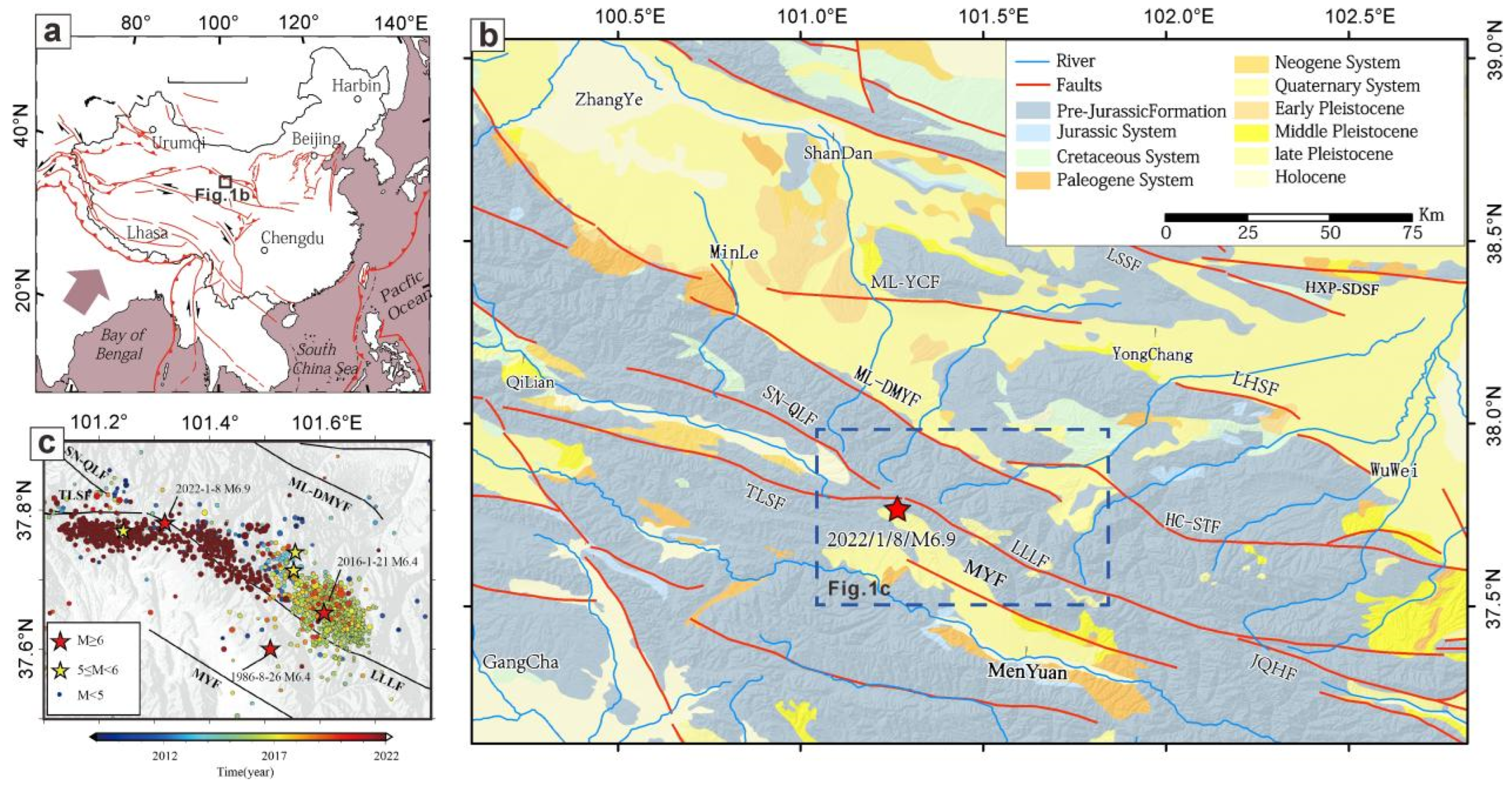
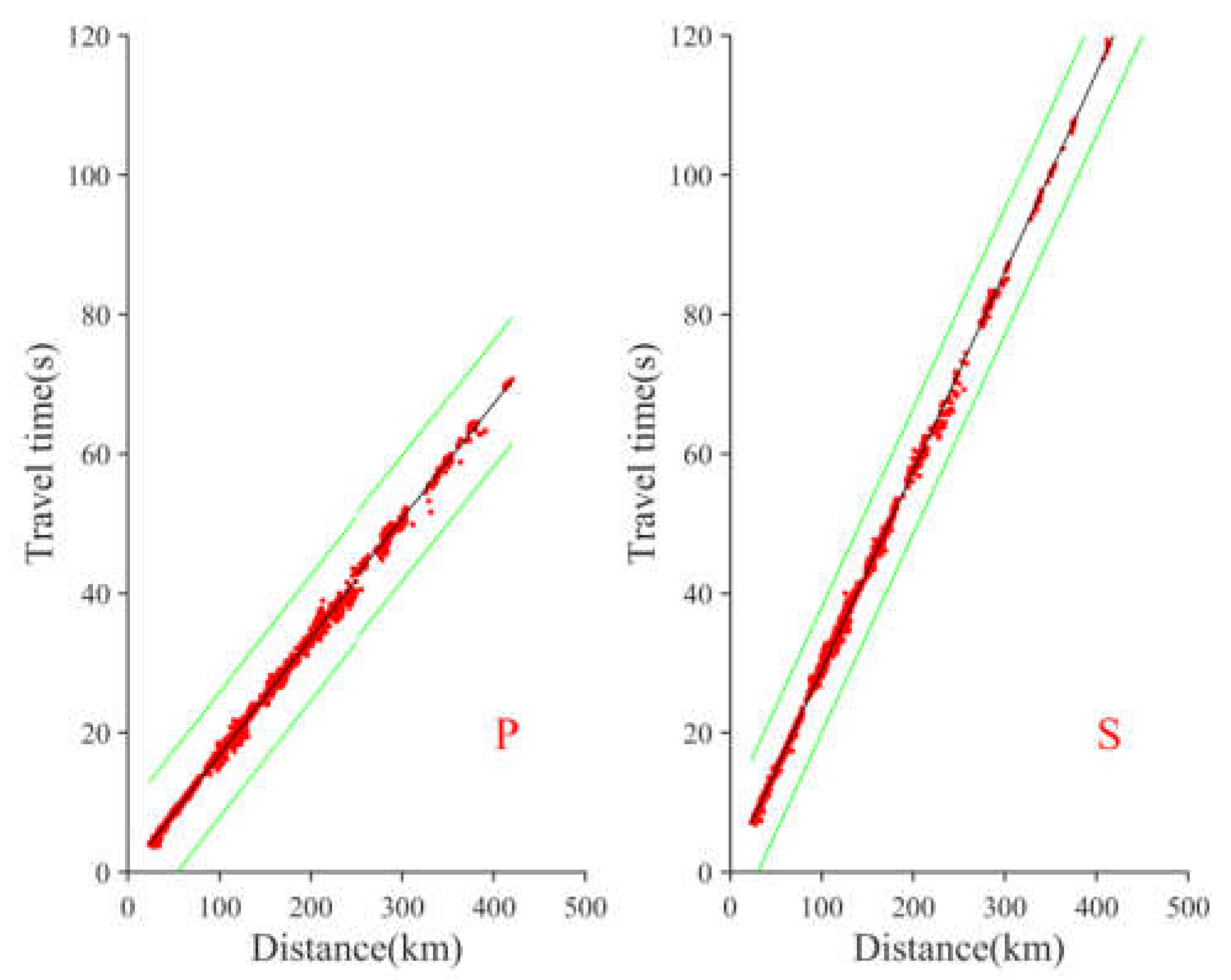
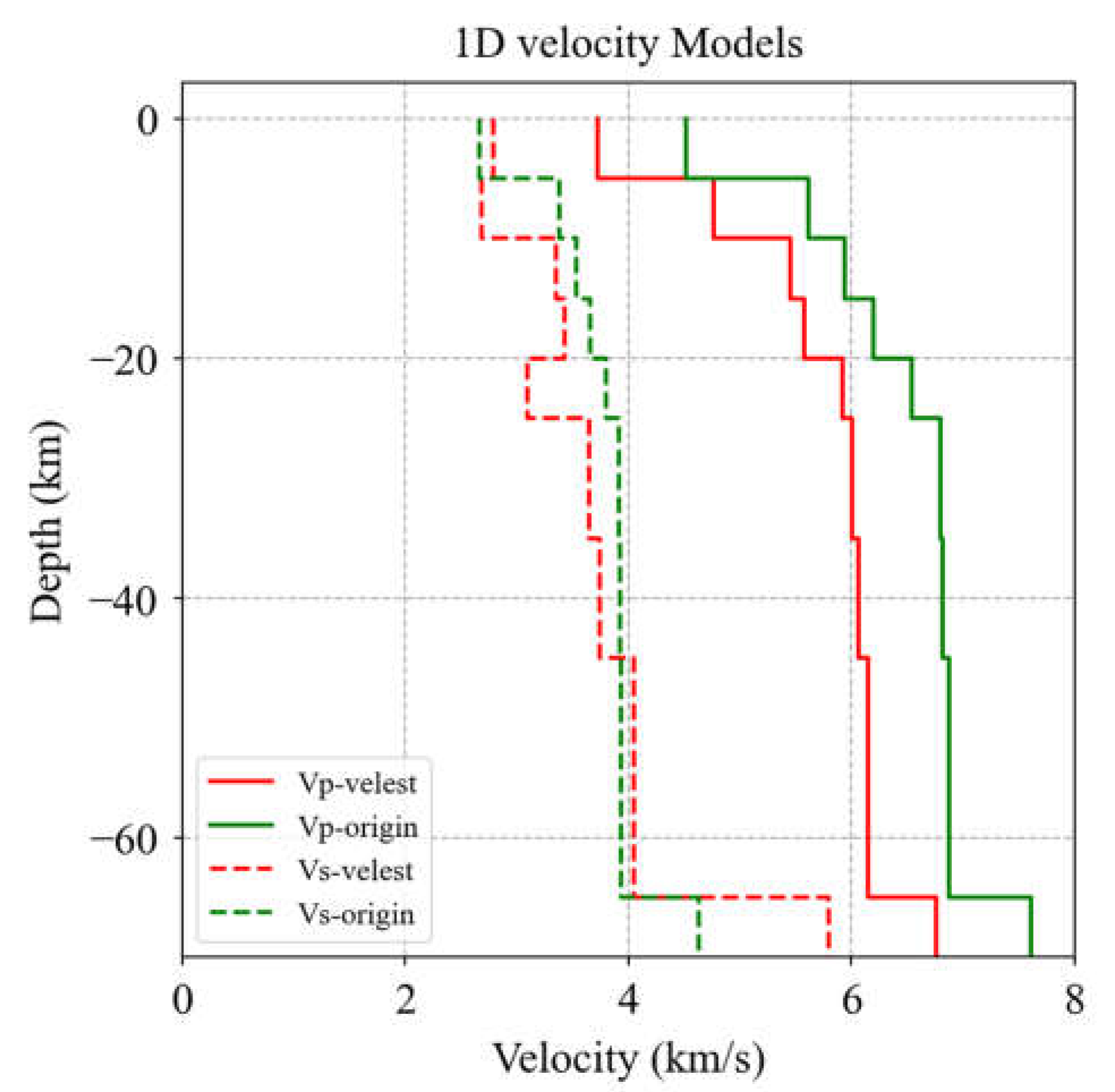
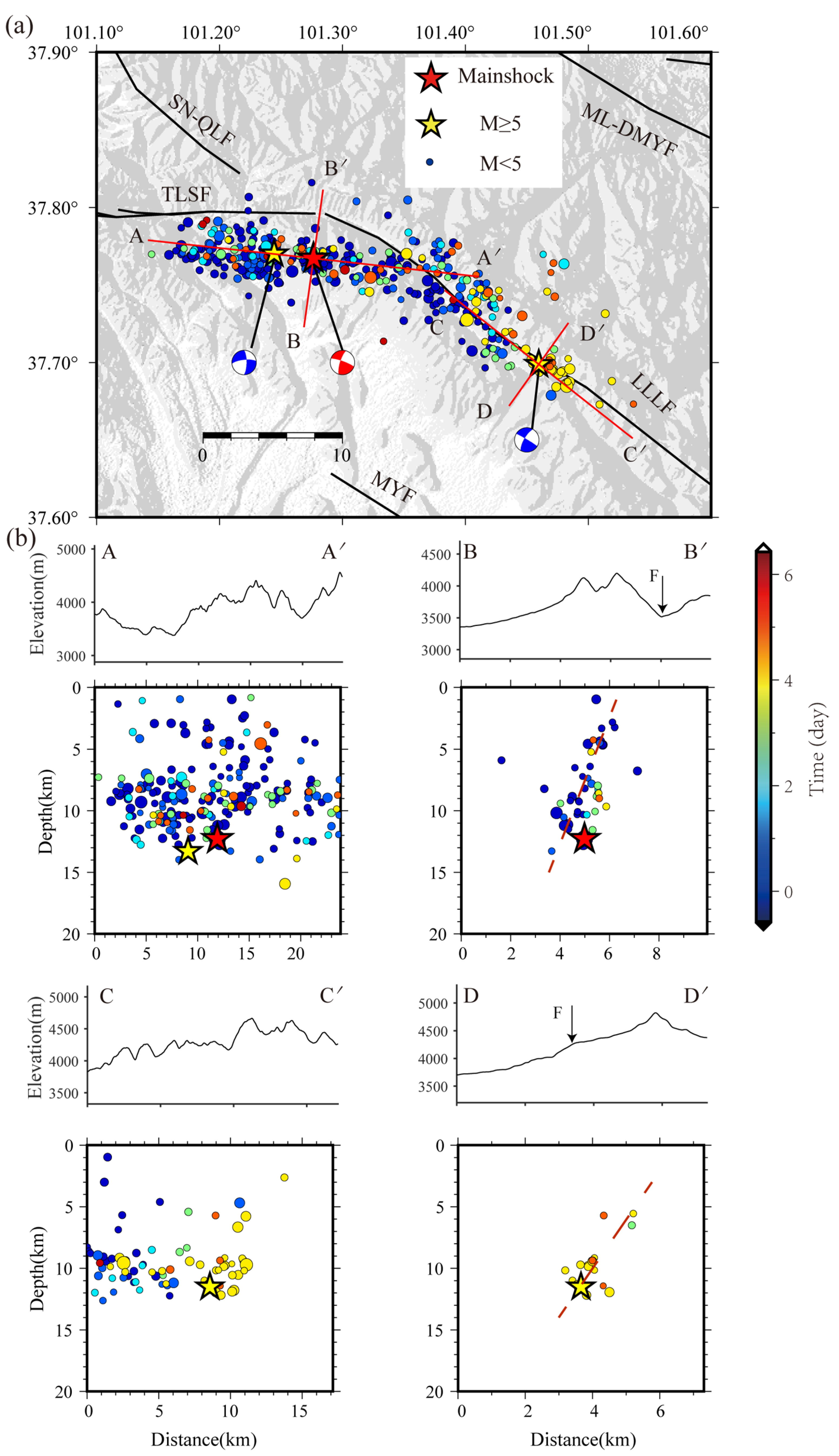
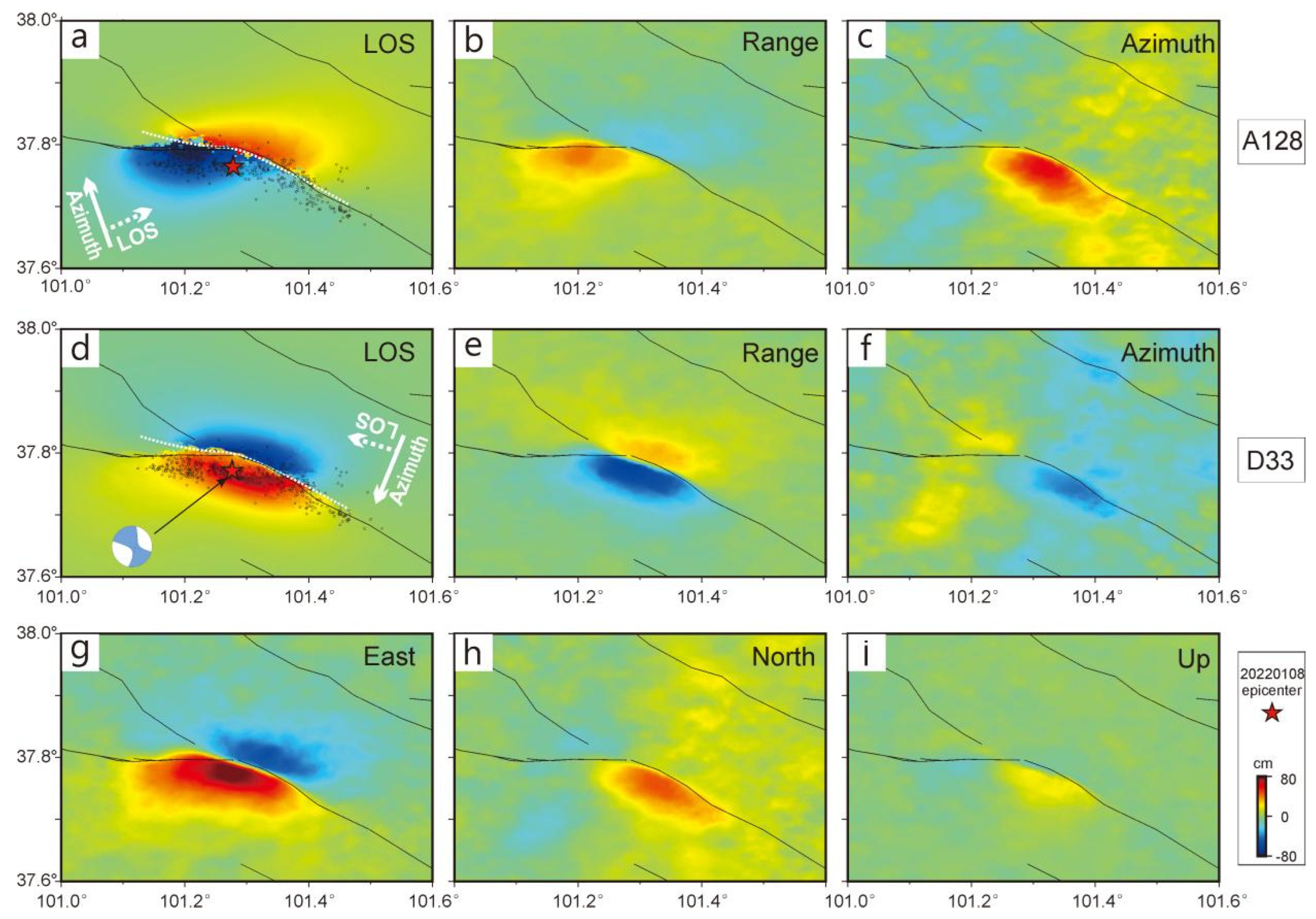
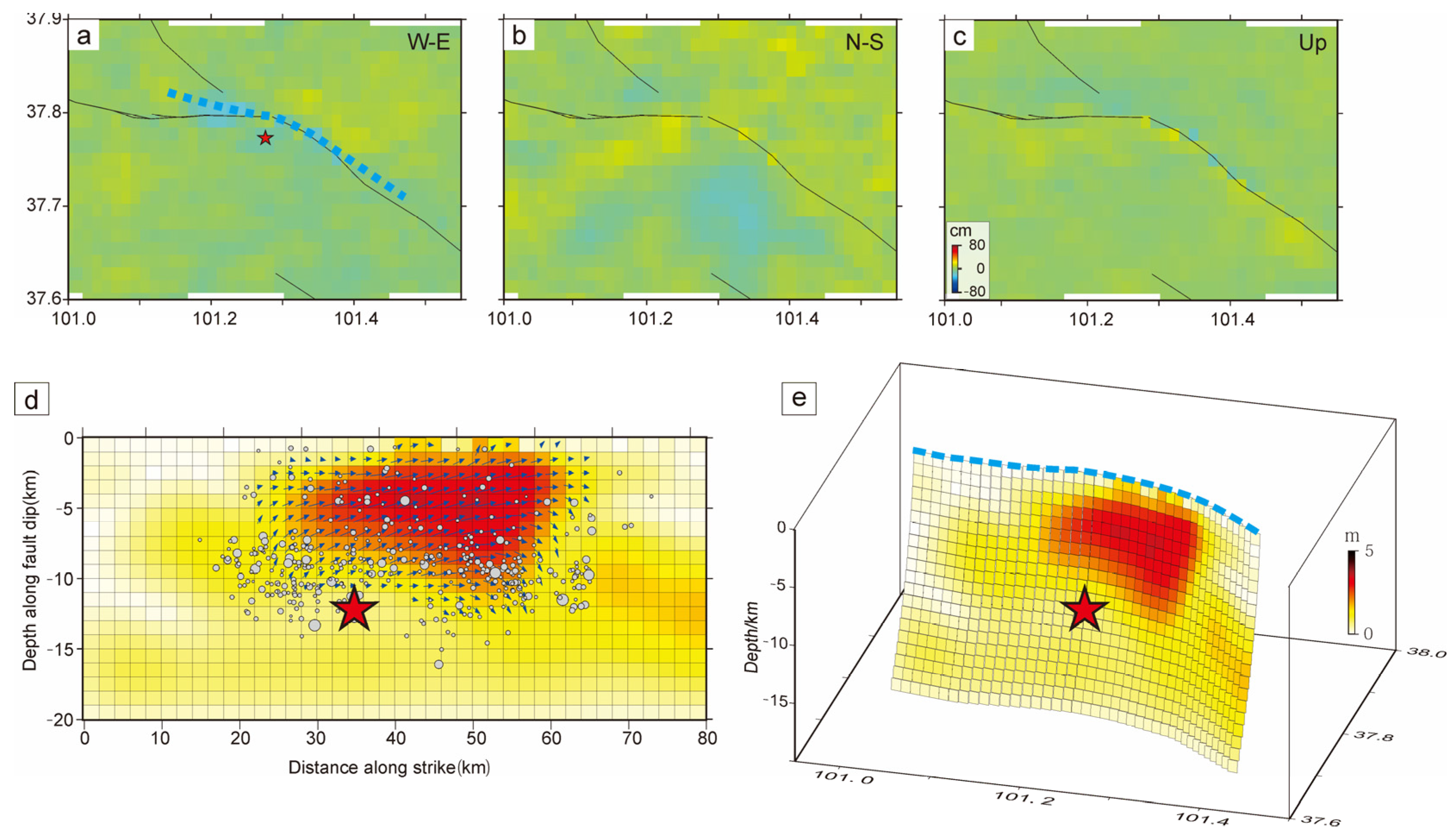
| Time | Long. (°) | Lat. (°) | Ms | Fault Plane 1 | Fault Plane 2 | Reference | ||||
|---|---|---|---|---|---|---|---|---|---|---|
| (°) | (°) | (°) | (°) | (°) | (°) | |||||
| 21 January 2016 | 101.62 | 37.65 | 6.4 | 143 | 40 | 71 | 347 | 53 | 105 | [46] |
| 8 January 2022 | 101.26 | 37.77 | 6.6 | 290 | 81 | 16 | 197 | 74 | 171 | [51] |
| 8 January 2022 | 101.22 | 37.77 | 5.1 | 0 | 73 | −161 | 264 | 72 | −18 | [51] |
| 12 January 2022 | 101.47 | 37.70 | 5.2 | 210 | 72 | 177 | 301 | 87 | 18 | [51] |
| Model | Orbit No. | Image Date | Baseline Distance (m) | Time Interval (Day) | |
|---|---|---|---|---|---|
| Pre-Shock | AFTER-Shock | ||||
| ascending orbit | A128 | 5 January 2022 | 17 January 2022 | 38.4 | 12 |
| descending orbit | D33 | 29 December 2021 | 10 January 2022 | 55.8 | 12 |
Disclaimer/Publisher’s Note: The statements, opinions and data contained in all publications are solely those of the individual author(s) and contributor(s) and not of MDPI and/or the editor(s). MDPI and/or the editor(s) disclaim responsibility for any injury to people or property resulting from any ideas, methods, instructions or products referred to in the content. |
© 2023 by the authors. Licensee MDPI, Basel, Switzerland. This article is an open access article distributed under the terms and conditions of the Creative Commons Attribution (CC BY) license (https://creativecommons.org/licenses/by/4.0/).
Share and Cite
Yin, X.; Zhai, H.; Cai, R.; Qiu, J.; Zou, X. Tectonic Implication of the 2022 MS 6.9 Earthquake in Menyuan, Qinghai, China: Analysis of Precise Earthquake Locations and InSAR. Sensors 2023, 23, 2128. https://doi.org/10.3390/s23042128
Yin X, Zhai H, Cai R, Qiu J, Zou X. Tectonic Implication of the 2022 MS 6.9 Earthquake in Menyuan, Qinghai, China: Analysis of Precise Earthquake Locations and InSAR. Sensors. 2023; 23(4):2128. https://doi.org/10.3390/s23042128
Chicago/Turabian StyleYin, Xinxin, Hongyu Zhai, Run Cai, Jiangtao Qiu, and Xiaobo Zou. 2023. "Tectonic Implication of the 2022 MS 6.9 Earthquake in Menyuan, Qinghai, China: Analysis of Precise Earthquake Locations and InSAR" Sensors 23, no. 4: 2128. https://doi.org/10.3390/s23042128






